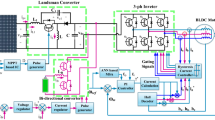Abstract
In this paper, a novel approach is proposed for solving the parameter design problem of brushless direct current (BLDC) motor, which is based on the membrane computing (MC) and pigeon-inspired optimization (PIO) algorithm. The motor parameter design problem is converted to an optimization problem with five design parameters and six constraints. The PIO algorithm is introduced into the framework of MC for improving the global convergence performance. The hybrid algorithm can improve the population diversity with better searching efficiency. Comparative simulations are conducted, and comparative results are given to show the feasibility and effectiveness of our proposed hybrid algorithm for high nonlinear optimization problems.
Similar content being viewed by others
References
Sun C H, Duan H B. Markov decision evolutionary game theoretic learning for cooperative sensing of unmanned aerial vehicles. Sci China Tech Sci, 2015, 58: 1392–1400
Duan H B, Liu S Q. Unmanned air/ground vehicles heterogeneous cooperative techniques: Current status and prospects. Sci China Tech Sci, 2010, 53: 1349–1355
Hua C, Qi J, Shang H, et al. Detection of collapsed buildings with the aerial images captured from UAV. Sci China Inf Sci, 2016, 59: 032102
Wang Y, Wang D. Variable thrust directional control technique for plateau unmanned aerial vehicles. Sci China Inf Sci, 2016, 59: 033201
Zhu X Y, Cheng M. Design, analysis and control of hybrid excited doubly salient stator-permanent-magnet motor. Sci China Tech Sci, 2010, 53: 188–199
Hou L, Chen Y S. Super-harmonic responses analysis for a cracked rotor system considering inertial excitation. Sci China Tech Sci, 2015, 58: 1924–1934
Hou L, Chen Y S. Analysis of 1/2 sub-harmonic resonance in a maneuvering rotor system. Sci China Tech Sci, 2014, 57: 203–209
Duan H B, Li S T, Shi Y H. Predator-prey brain storm optimization for DC brushless motor. IEEE T Magn, 2013, 49: 5336–5340
Qiu H X, Duan H B. Multi-objective pigeon-inspired optimization for brushless direct current motor parameter design. Sci China Tech Sci, 2015, 58: 1915–1923
Coelho L S, Barbosa L Z, Lebensztajn L. Multi-objective particle swarm approach for the design of a brushless DC wheel motor. IEEE T Magn, 2010, 46: 2994–2997
Duan H B, Li P. Bio-inspired Computation in Unmanned Aerial Vehicles. New York: Springer-Verlag Berlin Heidelberg, 2014
Bu H J, Zhang J, Luo Y Z, et al. Multi-objective optimization of space station short-term mission planning. Sci China Tech Sci, 2015, 58: 2169–2185
Qian C, Yu Y, Zhou Z H. Variable solution structure can be helpful in evolutionary optimization. Sci China Inf Sci, 2015, 58: 1–17
Zhao Z Q, Wu X D, Lu G Y, et al. Optimizing widths with PSO for center selection of Gaussian radial basis function networks. Sci China Tech Sci, 2014, 57: 1–17
Huang R F, Luo X W, Ji B, et al. Multi-objective optimization of a mixed-flow pump impeller using modified NSGA-II algorithm. Sci China Tech Sci, 2015, 58: 2122–2130
Zhang Y H, Jiao X H, Li L, et al. A hybrid dynamic programming- rule based algorithm for real-time energy optimization of plug-in hybrid electric bus. Sci China Tech Sci, 2014, 57: 2542–2550
Duan H B, Qiao P X. Pigeon-inspired optimization: A new swarm intelligence optimizer for air robot path planning. Int J Intell Comput and Cybern, 2014, 7: 24–37
Li C, Duan H B. Target detection approach for UAVs via improved pigeon-inspired optimization and edge potential function. Aerosp Sci Technol, 2014, 39: 352–360
Zhang S J, Duan H B. Gaussian pigeon-inspired optimization approach to orbital spacecraft formation reconfiguration. Chinese J Aeronaut, 2015, 28: 200–205
Zhang B, Duan H B. Three-dimensional path planning for uninhabited combat aerial vehicle based on predator-prey pigeon-inspired optimization in dynamic environment. IEEE/ACM T Comput Biol Bioinformatics, 2016, doi: 10.1109/TCBB.2015.2443789
Duan H B, Wang X H. Echo state networks with orthogonal pigeon-inspired optimization for image restoration. IEEE T Neural Networ Learn Syst, 2016, doi: 10.1109/TNNLS.2015.2479117
Paun G. Computing with membranes. J Comput Syst Sci, 2000, 61: 108–143
Paun G. Membrane Computing: An Introduction. New York: Springer- Verlag Berlin Heidelberg, 2002
Paun G, Paun R A. Membrane computing as a framework for modeling economic processes. In: Proceedings of IEEE International Symposium on Symbolic and Numeric Algorithms for Scientific Computing, Timisoara, Romania, 2005. 1–8
Brisset S, Brochet P. Analytical model for the optimal design of a brushless DC wheel motor. Compel, 2005, 24: 829–848
Shi Y, Eberhart R. A modified particle swarm optimizer. In: Proceedings of IEEE International Conference on Evolutionary Computation, Anchorage, Alaska, 1998. 69–73
Zhang Y, Zhang J. The imaging stability enhancement of optical payload using multiple vibration isolation platforms. J Vib Control, 2015, 21: 1848–1865
Duan H B, Li S T. Artificial bee colony based direct collocation for reentry trajectory optimization of hypersonic vehicle. IEEE T Aero Elec Sys, 2015, 51: 615–626
Zhang J R, Zhao S G, Zhang Y. Autonomous guidance for rendezvous phasing based on special-point-based maneuvers. J Guid Control Dynam, 2015, 38: 578–586
Zhou J, Wu X J, Liu Z R. Distributed coordinated adaptive tracking in networked redundant robotic systems with a dynamic leader. Sci China Tech Sci, 2014, 57: 905–913
Author information
Authors and Affiliations
Corresponding author
Rights and permissions
About this article
Cite this article
Deng, Y., Zhu, W. & Duan, H. Hybrid membrane computing and pigeon-inspired optimization algorithm for brushless direct current motor parameter design. Sci. China Technol. Sci. 59, 1435–1441 (2016). https://doi.org/10.1007/s11431-016-6048-8
Received:
Accepted:
Published:
Issue Date:
DOI: https://doi.org/10.1007/s11431-016-6048-8




